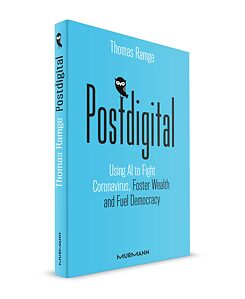myAI: The personal intelligence aid for well-informed decisions
In his latest book, artificial intelligence expert Thomas Ramge envisions a product of the future called “myAI”. He describes it as a digital personal assistant who only works in his best interest and not that of a tech giant.
Today, digital personal assistants like Alexa, Google Home or Siri are mostly used for providing information, making recommendations and buying products online. But these networked digital devices that are increasingly part of our lives are also changing fundamental cultural practices of reading, writing, listening and speaking. In addition, they are run by two of the biggest technology companies of our time, Amazon and Apple, respectively.
In his new book Postdigital - Using AI to Fight Coronavirus, Foster Wealth and Fuel Democracy, AI expert Thomas Ramge argues that with all the hype around AI, people are forgetting to question who benefits from the technology and to look closely at where it does more harm than good.
In the following edited excerpts from the book, Ramge transports the reader to the year 2030 as he takes his digital personal assistant “myAI” on a train journey from Berlin to Munich.
---
myAI wakes me up an hour before the usual time so I can catch the early train to Munich. For a long time, I refused to let the smart speaker from myAI into our home. I still think that smart speakers should be honest and call themselves smart microphones. But now, standing in front of the clothes closet, I’m glad I can ask myAI when exactly the ElectroShuttleTaxi to the train station will be here. My personal AI automatically arranged for the shared taxi yesterday after finding a discount ticket to Munich and booking it for me.
In my circle of friends, I was one of the first to get a myAI membership in 2026. Back then, my friends thought it was absurd to pay 100 Euros a month to an Israeli start-up whose advertising slogan was “You declare!” It was at least accurate: At the time, myAI couldn’t do much more than deliver the free, or at least much less expensive, AI assistants from Google, Apple, Amazon, Microsoft, Samsung and Tencent. My impression was that myAI’s appointment and travel planning worked a bit better, while its shopping assistance and dictation were worse. I couldn’t really judge the health apps. But at the time, I very consciously told myself: I’m tired of the obscure package of services that the big online platforms put together and where you’re never sure what data the platforms use, or what for.
myAI, in contrast, promised to act exclusively in my interest and in accordance with my preferences. The fine print of its terms and conditions clearly specified that myAI stores and processes all my data in Europe under cryptographic safeguards wherever that was sensible and possible. myAI is never allowed to provide data to third parties unless I give my explicit permission. At the time, it was absolutely clear to me: An AI assistant that’s always on your side and doesn’t try to sell you anything, spam you with ads, earn commissions on side deals with its corporate partners or try to keep you under its spell for as long as possible, but is instead programmed to minimize how much of your time it consumes has to be expensive. Or just not very good.
The system’s training phase took longer than promised. At first I had the feeling that it didn’t understand what I wanted. Today, though, myAI relieves me of a lot of routine decisions I used to waste a lot of time and effort on. Its help with shopping is still the feature that works best. Over the years, the system has gotten to know my preferences extremely well. For groceries, household and office supplies, I switched on the auto purchase feature years ago. myAI usually orders from the most affordable retailer unless their ratings are too low.
I also don’t waste two or three hours buying something like a bike lock online anymore. When I have to pay for something more expensive — or a lot more expensive — I look at myAI’s three suggestions. I usually just click on the “Your Best Deal” recommendation, and I get the impression that I’m now buying a lot less stuff that I later regret purchasing than I did before.
Incidentally, I wouldn’t have thought we would ever actually use the “Your Best Meal” feature with the linked shopping plan. My wife was strictly against it. And even I find it slightly humiliating that an AI is now telling us what we should eat. But somehow the system just found its way into our diet. We probably accept its suggestions three to four times a week, and we’re eating a more balanced diet with significantly less meat, which we’ve always talked about but never actually done. The meal plan illustrates one of the biggest strengths of myAI: effectively integrating basic life choices into all the little daily decisions. Behavioral psychologists would probably say my AI assistant is helping me to overcome the “value-action gap.”
I look at myAI’s little behavioral nudges above all as positive motivations in a learning process that leads to patterns of behavior in harmony with my fundamental idea of a good life. Far too often, I would act contrary to these ideas for the sake of convenience or due to inconsistency, and then I would think up excuses for myself. But now it feels like someone has flipped a switch.
Incidentally, this digitally enhanced self-control works especially well for recycling and reducing how much household waste we create. I finally have a much better way to judge how much garbage I’m bringing home (or having delivered) when I buy almost any product from almost every product category. For any product, its recycling potential, the CO2 emissions generated during its life cycle and overall environmental balance are extremely complicated. Or more precisely: Mostly it’s so complicated that I just give up on trying to figure it out. But myAI never gives up. There are a lot of criteria it has to compare and balance, but the criteria are clearly formulated and the characteristics are measurable. Unlike me, it doesn’t fall for greenwashing, because it’s not subject to my personal biases and cognitive limitations when it comes to weighing preferences and processing information.
For minor purchases, the system only gives me a brief note if the purchase isn’t in harmony with my “high environmental standards” guideline. For more significant decisions, however, myAI digs sufficiently deeply into the details without overwhelming me. It’s impressive how well the programmers succeeded in visualizing environmental impact so that I can form a much clearer picture to base my decision on. I see myAI as my personal intelligence enhancer for making informed decisions.
It doesn’t bother me that myAI manages both private and professional matters. I used to have to coordinate private appointments with my professional schedule, after all. I feel like my AI assistant has learned to distinguish between my private and professional preferences quite well. E-Mail ping-pong to make an appointment, I’m happy to say, is a thing of the past.
At last I sit down and put on my headphones. myAI checks me into my seat and asks: “Current news or background context?” I say: “Ten minutes of news, twenty minutes of background.” The system creates a podcast for me from the list of sources that I regularly select based on its suggestions. If a topic has direct political relevance for me, myAI tells me that just before the news report.
Occasionally I give the system feedback as to whether I agree with its estimate of relevance for me and my life. Then in a dialog window, three reasons always pop up for why the system thinks a topic is personally relevant for me. Then I can either confirm or reject each of the three reasons individually. This way the system continuously collects information, which is also fed into my recommended choices.
With conspicuous frequency, myAI informs me of AI-related topics. Sometimes I wonder if this is really only due to my own preferences or whether the system itself suffers from a self-serving distortion, a digital Lake Wobegon effect that assumes everyone is highly interested in AI. It recently put a fascinating podcast at the top of my playlist that addressed the question: “Is there a right to a basic level of access to AI?” myAI was mentioned as an example of how the latest AI assistants are increasing digital inequality. If you’ve got 100 Euros a month for an independent assistant, you can buy access to artificially enhanced intelligence. If you don’t have the money, you’re stuck with a cheap or free system and might even have to accept that your own data will be used to generate suggestions that run counter to your interests.
My daily info-podcast unit always ends with three minutes of serendipity input. I’ve given myAI strict instructions to add something on a topic that, according to the system’s data, I wouldn’t be interested in. The anti-recommendations are really good. Mostly the topic doesn’t actually interest me, but I can’t stop the serendipity input. Of course I could just take off the headphones, but I almost never do. Because then I’d feel physically and all too clearly that I was breaking my own rules. I fall asleep. myAI observes this, of course, lowers the volume of the music and turns up the noise cancellation. Shortly before Nuremberg, it wakes me up.
 Thomas Ramge
| Photo credit: Peter van Heesen
The system reminds me of the two tasks I’ve marked as “mandatory” for the train trip. From the inside pocket of my sport coat, I retrieve my data glasses and enter the room for presentations. myAI leads me one more time through the logic of the argument I hope to make later at my meeting. Using the gesture-based interface, I reorganize a slide and run the semantic consistency check on the notes under the charts. myAI states that it doesn’t find any inconsistencies and asks if I want to start a last run-through in real time. Thanks, but no thanks. I’d rather extend my chess training session instead.
Thomas Ramge
| Photo credit: Peter van Heesen
The system reminds me of the two tasks I’ve marked as “mandatory” for the train trip. From the inside pocket of my sport coat, I retrieve my data glasses and enter the room for presentations. myAI leads me one more time through the logic of the argument I hope to make later at my meeting. Using the gesture-based interface, I reorganize a slide and run the semantic consistency check on the notes under the charts. myAI states that it doesn’t find any inconsistencies and asks if I want to start a last run-through in real time. Thanks, but no thanks. I’d rather extend my chess training session instead.
I’m so absorbed by the chess match openings that I don’t even notice that we’re arriving at Munich’s main train station. Thankfully, myAI has already booked a seat in the shuttle taxi to the co-working space where the meeting will take place. myAI turns itself off with the notification that I’ve already used up 70 percent of the online time that I’ve granted myself, and it puts itself in low intervention mode. On the return trip, I’ll have to read. Or talk to other travelers. Or I’ll have to deliberately decide to grant myAI even more space in my life.
Learn more about Thomas Ramge's views on the future of creative AI here.
In his new book Postdigital - Using AI to Fight Coronavirus, Foster Wealth and Fuel Democracy, AI expert Thomas Ramge argues that with all the hype around AI, people are forgetting to question who benefits from the technology and to look closely at where it does more harm than good.
In the following edited excerpts from the book, Ramge transports the reader to the year 2030 as he takes his digital personal assistant “myAI” on a train journey from Berlin to Munich.
---
myAI wakes me up an hour before the usual time so I can catch the early train to Munich. For a long time, I refused to let the smart speaker from myAI into our home. I still think that smart speakers should be honest and call themselves smart microphones. But now, standing in front of the clothes closet, I’m glad I can ask myAI when exactly the ElectroShuttleTaxi to the train station will be here. My personal AI automatically arranged for the shared taxi yesterday after finding a discount ticket to Munich and booking it for me.
In my circle of friends, I was one of the first to get a myAI membership in 2026. Back then, my friends thought it was absurd to pay 100 Euros a month to an Israeli start-up whose advertising slogan was “You declare!” It was at least accurate: At the time, myAI couldn’t do much more than deliver the free, or at least much less expensive, AI assistants from Google, Apple, Amazon, Microsoft, Samsung and Tencent. My impression was that myAI’s appointment and travel planning worked a bit better, while its shopping assistance and dictation were worse. I couldn’t really judge the health apps. But at the time, I very consciously told myself: I’m tired of the obscure package of services that the big online platforms put together and where you’re never sure what data the platforms use, or what for.
myAI, in contrast, promised to act exclusively in my interest and in accordance with my preferences. The fine print of its terms and conditions clearly specified that myAI stores and processes all my data in Europe under cryptographic safeguards wherever that was sensible and possible. myAI is never allowed to provide data to third parties unless I give my explicit permission. At the time, it was absolutely clear to me: An AI assistant that’s always on your side and doesn’t try to sell you anything, spam you with ads, earn commissions on side deals with its corporate partners or try to keep you under its spell for as long as possible, but is instead programmed to minimize how much of your time it consumes has to be expensive. Or just not very good.
The system’s training phase took longer than promised. At first I had the feeling that it didn’t understand what I wanted. Today, though, myAI relieves me of a lot of routine decisions I used to waste a lot of time and effort on. Its help with shopping is still the feature that works best. Over the years, the system has gotten to know my preferences extremely well. For groceries, household and office supplies, I switched on the auto purchase feature years ago. myAI usually orders from the most affordable retailer unless their ratings are too low.
I also don’t waste two or three hours buying something like a bike lock online anymore. When I have to pay for something more expensive — or a lot more expensive — I look at myAI’s three suggestions. I usually just click on the “Your Best Deal” recommendation, and I get the impression that I’m now buying a lot less stuff that I later regret purchasing than I did before.
Incidentally, I wouldn’t have thought we would ever actually use the “Your Best Meal” feature with the linked shopping plan. My wife was strictly against it. And even I find it slightly humiliating that an AI is now telling us what we should eat. But somehow the system just found its way into our diet. We probably accept its suggestions three to four times a week, and we’re eating a more balanced diet with significantly less meat, which we’ve always talked about but never actually done. The meal plan illustrates one of the biggest strengths of myAI: effectively integrating basic life choices into all the little daily decisions. Behavioral psychologists would probably say my AI assistant is helping me to overcome the “value-action gap.”
I look at myAI’s little behavioral nudges above all as positive motivations in a learning process that leads to patterns of behavior in harmony with my fundamental idea of a good life. Far too often, I would act contrary to these ideas for the sake of convenience or due to inconsistency, and then I would think up excuses for myself. But now it feels like someone has flipped a switch.
Incidentally, this digitally enhanced self-control works especially well for recycling and reducing how much household waste we create. I finally have a much better way to judge how much garbage I’m bringing home (or having delivered) when I buy almost any product from almost every product category. For any product, its recycling potential, the CO2 emissions generated during its life cycle and overall environmental balance are extremely complicated. Or more precisely: Mostly it’s so complicated that I just give up on trying to figure it out. But myAI never gives up. There are a lot of criteria it has to compare and balance, but the criteria are clearly formulated and the characteristics are measurable. Unlike me, it doesn’t fall for greenwashing, because it’s not subject to my personal biases and cognitive limitations when it comes to weighing preferences and processing information.
For minor purchases, the system only gives me a brief note if the purchase isn’t in harmony with my “high environmental standards” guideline. For more significant decisions, however, myAI digs sufficiently deeply into the details without overwhelming me. It’s impressive how well the programmers succeeded in visualizing environmental impact so that I can form a much clearer picture to base my decision on. I see myAI as my personal intelligence enhancer for making informed decisions.
It doesn’t bother me that myAI manages both private and professional matters. I used to have to coordinate private appointments with my professional schedule, after all. I feel like my AI assistant has learned to distinguish between my private and professional preferences quite well. E-Mail ping-pong to make an appointment, I’m happy to say, is a thing of the past.
At last I sit down and put on my headphones. myAI checks me into my seat and asks: “Current news or background context?” I say: “Ten minutes of news, twenty minutes of background.” The system creates a podcast for me from the list of sources that I regularly select based on its suggestions. If a topic has direct political relevance for me, myAI tells me that just before the news report.
Occasionally I give the system feedback as to whether I agree with its estimate of relevance for me and my life. Then in a dialog window, three reasons always pop up for why the system thinks a topic is personally relevant for me. Then I can either confirm or reject each of the three reasons individually. This way the system continuously collects information, which is also fed into my recommended choices.
With conspicuous frequency, myAI informs me of AI-related topics. Sometimes I wonder if this is really only due to my own preferences or whether the system itself suffers from a self-serving distortion, a digital Lake Wobegon effect that assumes everyone is highly interested in AI. It recently put a fascinating podcast at the top of my playlist that addressed the question: “Is there a right to a basic level of access to AI?” myAI was mentioned as an example of how the latest AI assistants are increasing digital inequality. If you’ve got 100 Euros a month for an independent assistant, you can buy access to artificially enhanced intelligence. If you don’t have the money, you’re stuck with a cheap or free system and might even have to accept that your own data will be used to generate suggestions that run counter to your interests.
My daily info-podcast unit always ends with three minutes of serendipity input. I’ve given myAI strict instructions to add something on a topic that, according to the system’s data, I wouldn’t be interested in. The anti-recommendations are really good. Mostly the topic doesn’t actually interest me, but I can’t stop the serendipity input. Of course I could just take off the headphones, but I almost never do. Because then I’d feel physically and all too clearly that I was breaking my own rules. I fall asleep. myAI observes this, of course, lowers the volume of the music and turns up the noise cancellation. Shortly before Nuremberg, it wakes me up.
 Thomas Ramge
| Photo credit: Peter van Heesen
The system reminds me of the two tasks I’ve marked as “mandatory” for the train trip. From the inside pocket of my sport coat, I retrieve my data glasses and enter the room for presentations. myAI leads me one more time through the logic of the argument I hope to make later at my meeting. Using the gesture-based interface, I reorganize a slide and run the semantic consistency check on the notes under the charts. myAI states that it doesn’t find any inconsistencies and asks if I want to start a last run-through in real time. Thanks, but no thanks. I’d rather extend my chess training session instead.
Thomas Ramge
| Photo credit: Peter van Heesen
The system reminds me of the two tasks I’ve marked as “mandatory” for the train trip. From the inside pocket of my sport coat, I retrieve my data glasses and enter the room for presentations. myAI leads me one more time through the logic of the argument I hope to make later at my meeting. Using the gesture-based interface, I reorganize a slide and run the semantic consistency check on the notes under the charts. myAI states that it doesn’t find any inconsistencies and asks if I want to start a last run-through in real time. Thanks, but no thanks. I’d rather extend my chess training session instead.I’m so absorbed by the chess match openings that I don’t even notice that we’re arriving at Munich’s main train station. Thankfully, myAI has already booked a seat in the shuttle taxi to the co-working space where the meeting will take place. myAI turns itself off with the notification that I’ve already used up 70 percent of the online time that I’ve granted myself, and it puts itself in low intervention mode. On the return trip, I’ll have to read. Or talk to other travelers. Or I’ll have to deliberately decide to grant myAI even more space in my life.
Learn more about Thomas Ramge's views on the future of creative AI here.




